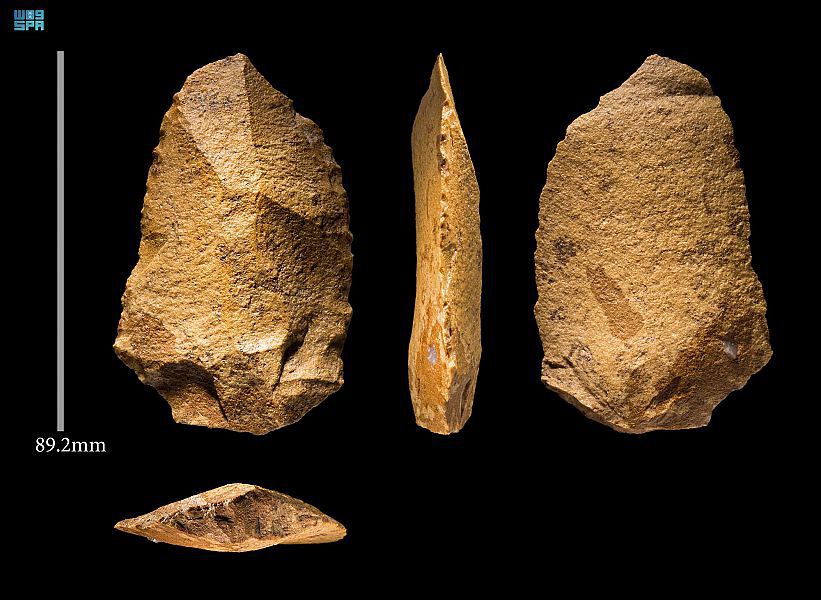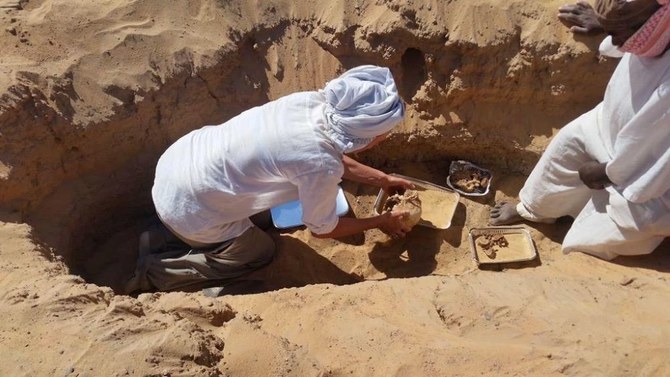
Experts found stone tools and other evidence of human activity in northern Saudi Arabia dating back as far as 400,000 years
This confirms the Kingdom’s civilizational importance, and the role of communities outside of Africa in human development, experts said
JEDDAH: Recent archaeological discoveries in northern Saudi Arabia reveal the earliest evidence of human migrations from the African continent to the Arabian Peninsula about 400,000 years ago, the Saudi Heritage Authority has announced.
They confirm the Kingdom’s civilizational importance, and the role played by early communities outside of the African continent in human development, experts said.
The international team involved in the research includes Saudi specialists from the Heritage Authority, along with experts from King Saud University, the Max Planck Institute in Germany, and a number of other international universities and institutions.
They found the remains of stone tools and fossilized animal bones in the layers of dried-up lakes in the Nafud Desert, in the northwest of the Kingdom.
Artifacts dating back about 400,000 years, including Acheulean axes, were found at Khal Amishan, on the outskirts of Tabuk. They are considered the oldest archaeological remains on record in the Arabian Peninsula. The indicate migrations that were repeated periodically during multiple stages, including 300,000, 200,000, 130,000-75,000 and 55,000 years ago.
An article published in the renowned Nature magazine on Wednesday details the discoveries made in the layers of sediment left behind by the ancient lakes that formed at Jubbah and Khal Amishan during rainy periods in the history of the region.
It reveals that various stages of human existence and development can be traced through the archaeological artifacts, which reveal the differences between successive groups of humans and the development of stone crafts.
The study advances knowledge of the time periods during which human migrations from Africa to the Arabian Peninsula took place, during which a more temperate climate prevailed in the region.
It details evidence of Acheulean stone crafts dating back 200,000 years, which is relatively recent compared to other examples found in southwest Asia. This shows the cultural peculiarity of early humans in the Arabian Peninsula, and how the region was shaped by the environmental and cultural conditions of the time.
The study confirms that the archaeological sites are associated with the crafting of stone tools, rather than living areas used by early human groups.
Khal Amishan has several archaeological layers that reveal environmental information from various periods. The earliest layer, dating back about 400,000 years, contains the Arabian Peninsula’s oldest archaeological remains, including the Acheulean axes. The layer above it, which is about 300,000 years old, contains stone axes characterized by their small size.
The next layer, dating back 200,000 years, includes stone tools but no axes were found. It revealed the first evidence of a manufacturing technique known as Levalloisian.
Of the remaining archaeological layers, the first is between 75,000 and 125,000 years old, while the most recent one dates back about 55,000 years. They are characterized by tools made using the Levalloisian technique, which spread during the Acheulean civilization that endured until the more humid periods of the Quaternary Pleistocene Epoch.
This stone craft was unique in terms of its technical aspects, and is nothing like other stone-crafting techniques that were common in the eastern Mediterranean region. According to the study, the cultural characteristics of the Levalloisian technique in the Nafud Desert is closer to techniques found in eastern Africa.
The study of the skeletal remains of animals revealed the presence of hippos and other bovids across several time periods. This confirms the presence of an environment in the north of the Arabian Peninsula that was rich in water sources and dense plant coverage — which matches the prevailing climatic conditions in North Africa at the time.
The research team was able to identify five waves of human migration from Africa to the Arabian Peninsula, linked to improvements in climatic conditions and a reduced risk of drought.
Two of the examples of stone crafts that were discovered belong to the Acheulean civilization, while the remaining three belong to the Middle Paleolithic period. This confirms the differences between successive human groups.
The scientific team also presented the results of an archaeological study of a site at Jubbah in Hail. Once an ancient lake, it contains archaeological layers similar to those found in Khal Amishan.











